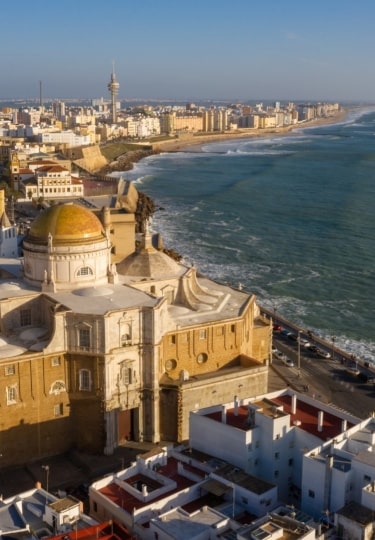Southern Spain, with its brilliant sunshine, sweeping Mediterranean vistas and lengthy beaches, along with its Hispano-Moorish architecture, is a must if you’re keen to gain an insight into one of the country’s most vibrant regional cultures.
From the impressive panoramas atop Málaga’s Berber-built hilltop castle to the serene alpine beauty of the Sierra Nevada National Park, or time spent lounging along Cadiz’s golden La Caleta Beach, there’s no shortage of things to do in the south of Spain.
It doesn’t matter if you’re a mountain climber, a sea lover, a gourmand, a fashionista, or a history buff; southern Spain will satiate all of your appetites, from rollicking adventures in nature to city-based galleries, museums, and forays into Andalucia’s rich gastronomy.
Why Visit Southern Spain
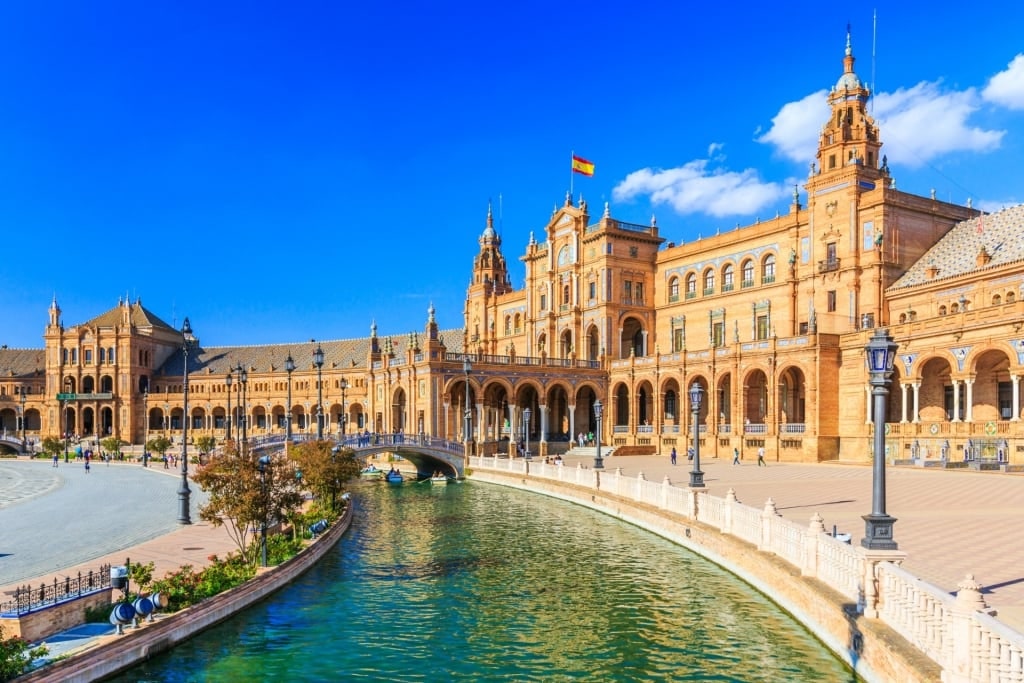
Seville
If sampling tasty tapas that Spain is known for appeals, that might be reason enough for you to call on this slice of the Iberian Peninsula. Catching a stylish flamenco performance full of music and dance in romantic Seville is an added incentive to visit southern Spain.
And while tapas and flamenco are both cornerstones of the Spanish identity, and shouldn’t be missed, Andalusia is also a bastion of art (as demonstrated by the Museo Picasso Malaga), with incredible buildings and fortress museums like Granada’s Alhambra, or Cordoba’s Mezquita mosque.
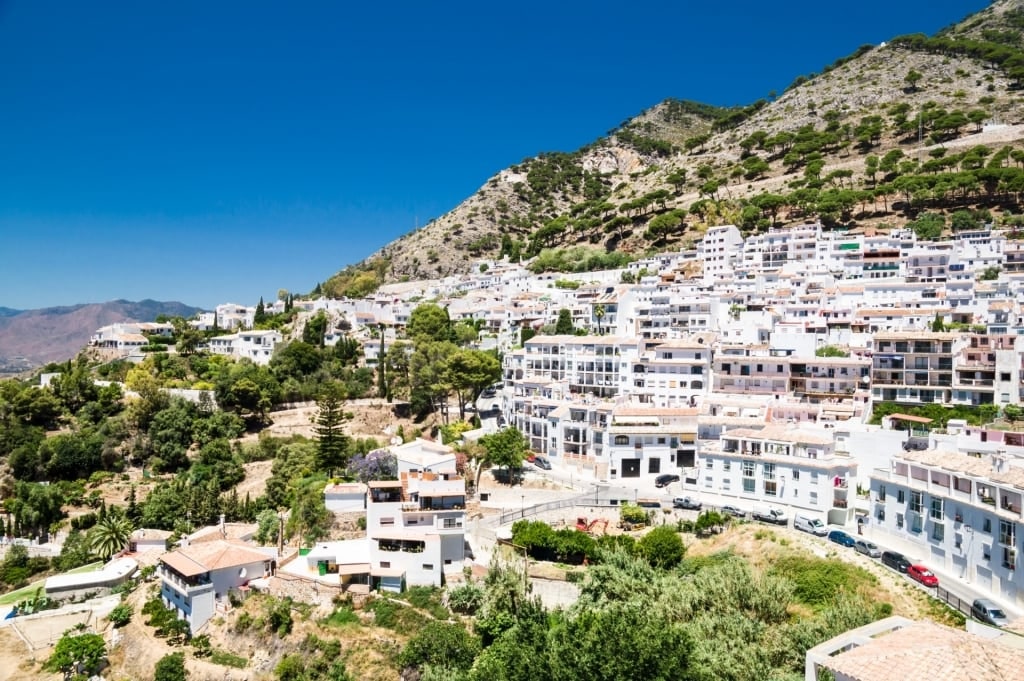
Mijas
Beautiful Spanish towns like Ronda, famed for its gorge-spanning Puente Nuevo Bridge, and Mijas, with its stark white hillside façades, only enhance Andalusia’s charm.
History & Culture
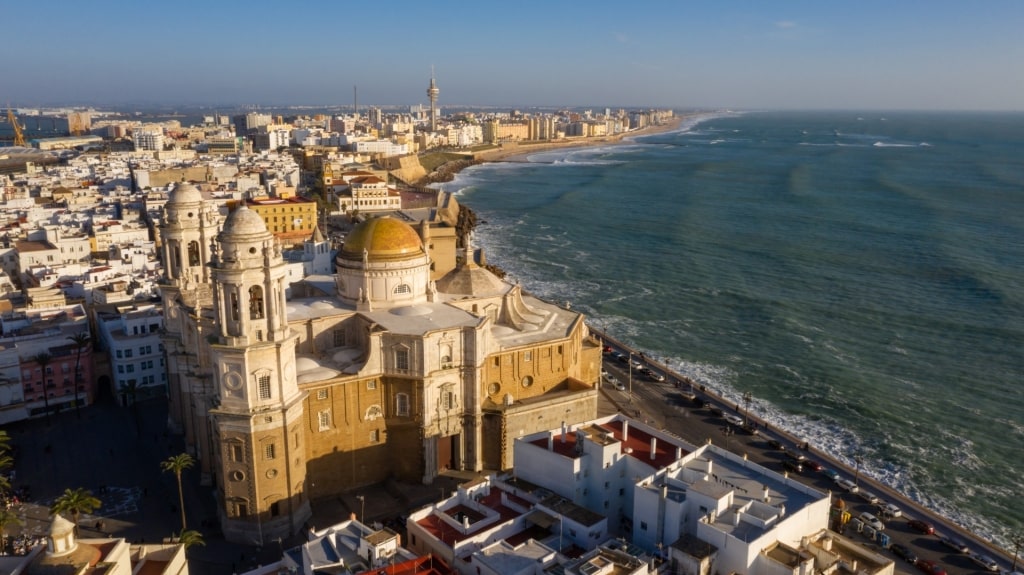
Cadiz
The south of Spain has a long and wild history, marked by invasions, competing dynasties, century-long campaigns for regional supremacy, and extended periods of peace and prosperity.
Originally settled by the Phoenicians around Cadiz in 1100 BC, Spain’s southern seaboard also saw Celtic and Greek peoples move in at various times to establish trading posts.
The Carthaginians came into power in the region around 500 BC but were eventually displaced by the Romans, led by the general Scipio Africanus. The Roman province of Hispania Baetica was established in 14 BC.
As Rome began to break apart, the militaristic Visigoths became the predominant “barbarian” tribe controlling the region, until North African Moors moved in and took over.
The Moors presided over much of southern Spain, which they called Al-Andalus for eight centuries.
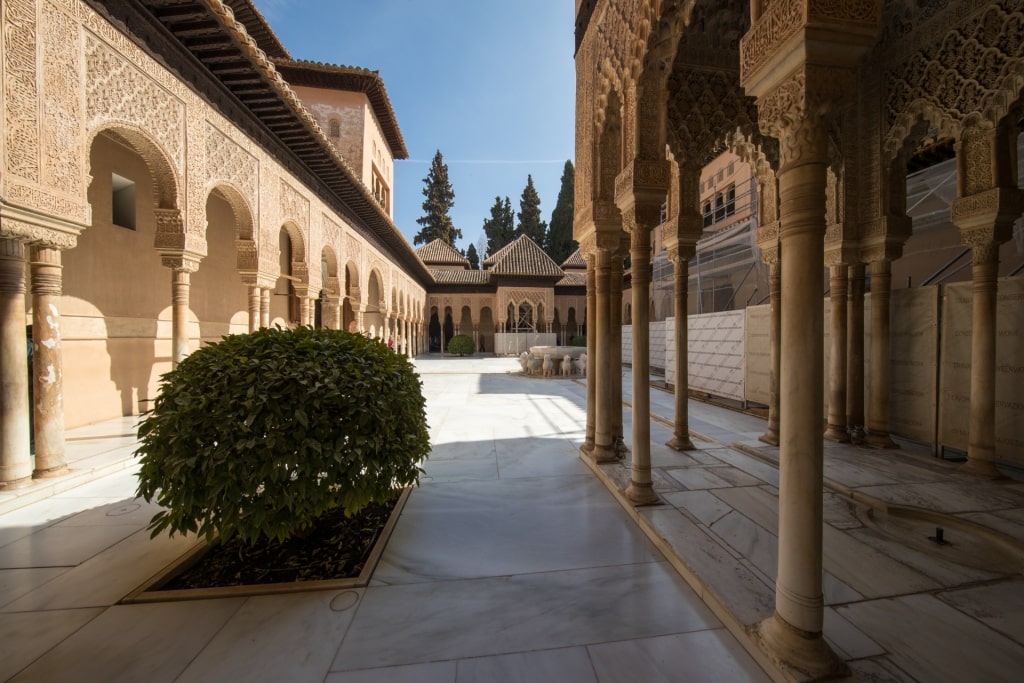
Alhambra Palace, Granada
Different Muslim dynasties controlled southern Iberia over the centuries, including the Umayyads, the Almohads, and the Nasrids. Islamic culture, architecture and learning flourished during these periods, as evidenced by Granada’s Alhambra Palace, and Cordoba’s Mezquita, both of which you can still visit today.
The Reconquista, in which Christian armies pushed the Muslim dynasties out, came to an end in the 15th century. The power couple of Ferdinand of Aragon and Isabel of Castille saw off the last of the Nasrid sultans, Abdallah Muhammad bin Ali, or Boabdil, from his hillside fortress in Granada in 1492.
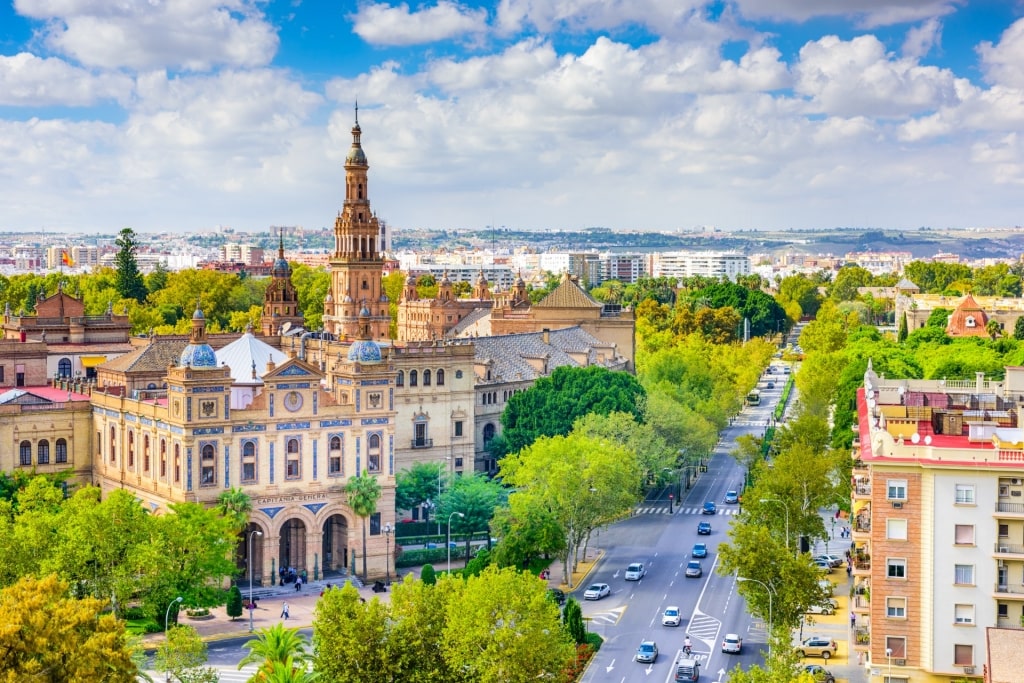
Seville
Seville became a focal point for explorers like Columbus (backed by Isabel of Castille) to set off across the Atlantic to the New World, opening up the Americas to European colonization.
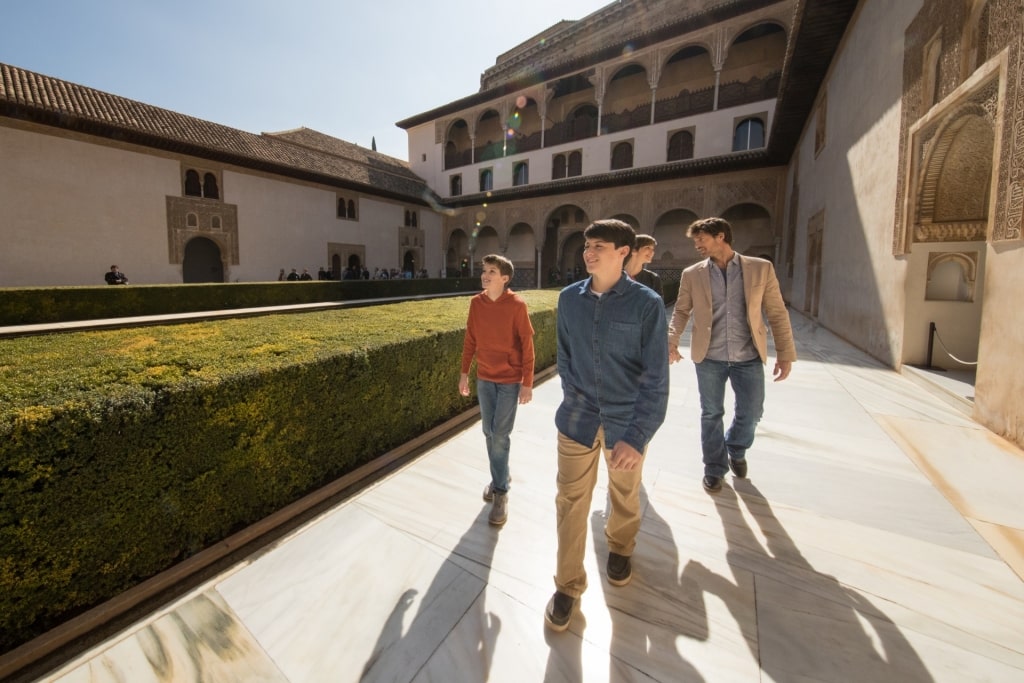
Alhambra Palace, Granada
Today, southern Spain’s historical mix of Moorish and Spanish traditions can be seen in the architecture, food (saffron, apricots, date palms, for example), and even in the music, with the flamenco guitar style heavily influenced by North African rhythms and melodic roots.
Tips for Visiting Southern Spain
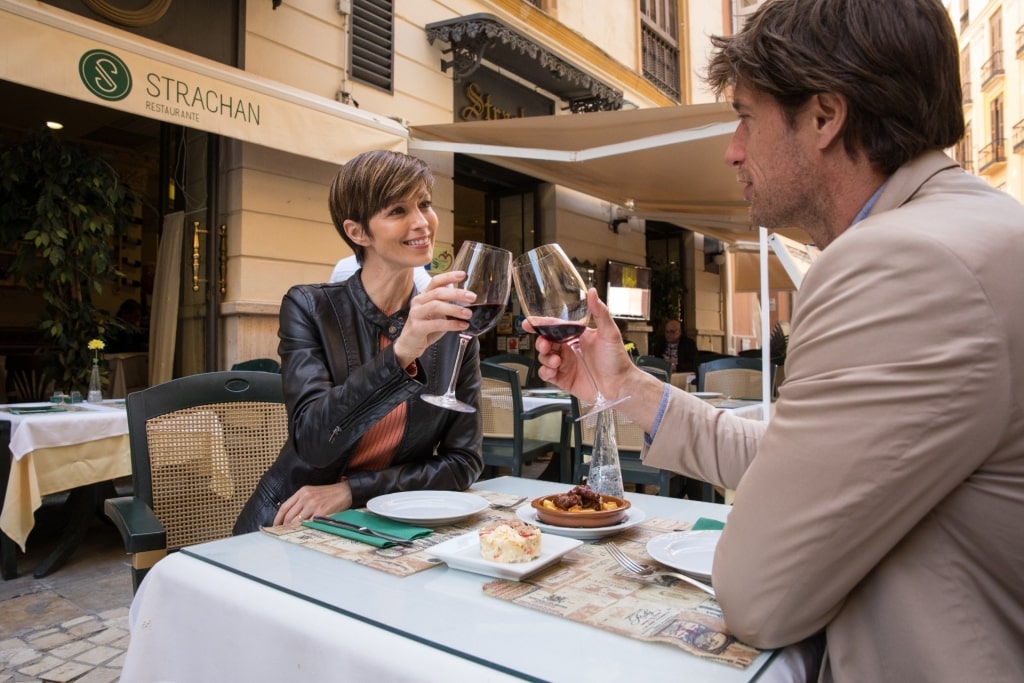
Tapas tasting in Malaga
There’s a good reason why the siesta, or afternoon nap, is associated with the south of Spain. The weather can get very hot, especially during late spring and summer, which is why it’s a good idea to find some shade for cover or a cool café when the sun reaches its zenith.
If you’re by the coast, a Mediterranean breeze often kicks up in the afternoon, which can offer you a reprieve from the warmth as well.
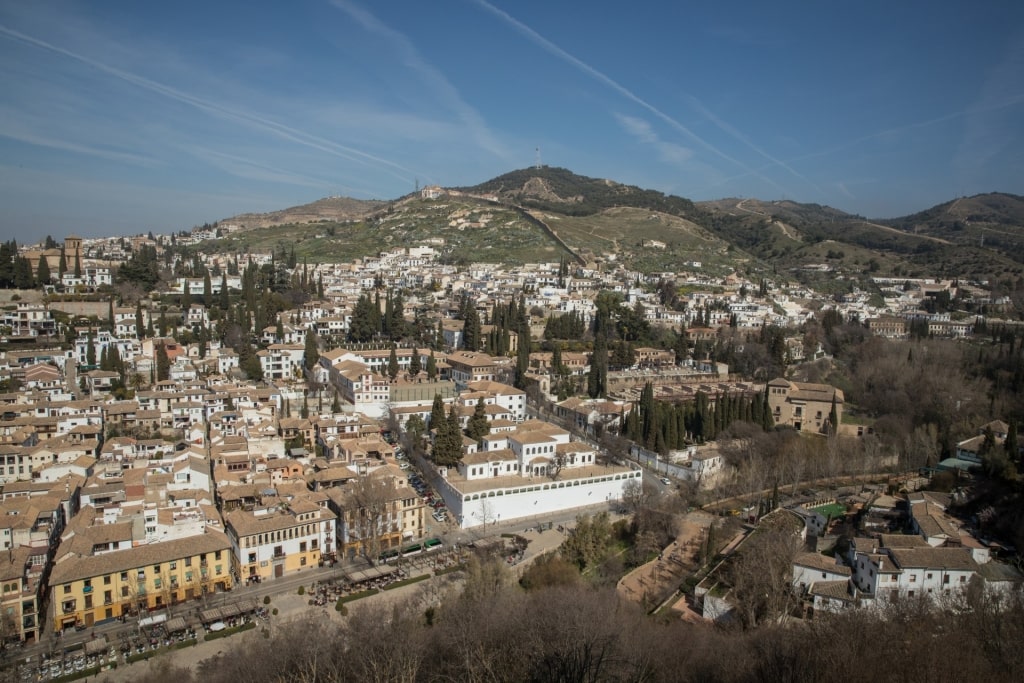
Granada
Some of Spain’s best cities like Granada, Málaga, and Seville are immensely walkable—with plenty of outstanding architecture to catch your eye—which is why you should invest in a good pair of comfy walking shoes. That being said, some spots, like Granada, do come with some challenging hills.
The Spanish tend to eat dinner late, well after 8.30 pm. You can always snack on tapas, though, with your aperitif.
In quieter towns, during siesta (about 2 pm to 4 or 5 pm), many shops will close, so plan your afternoon shopping for Spanish souvenirs accordingly.
Wildlife & Nature
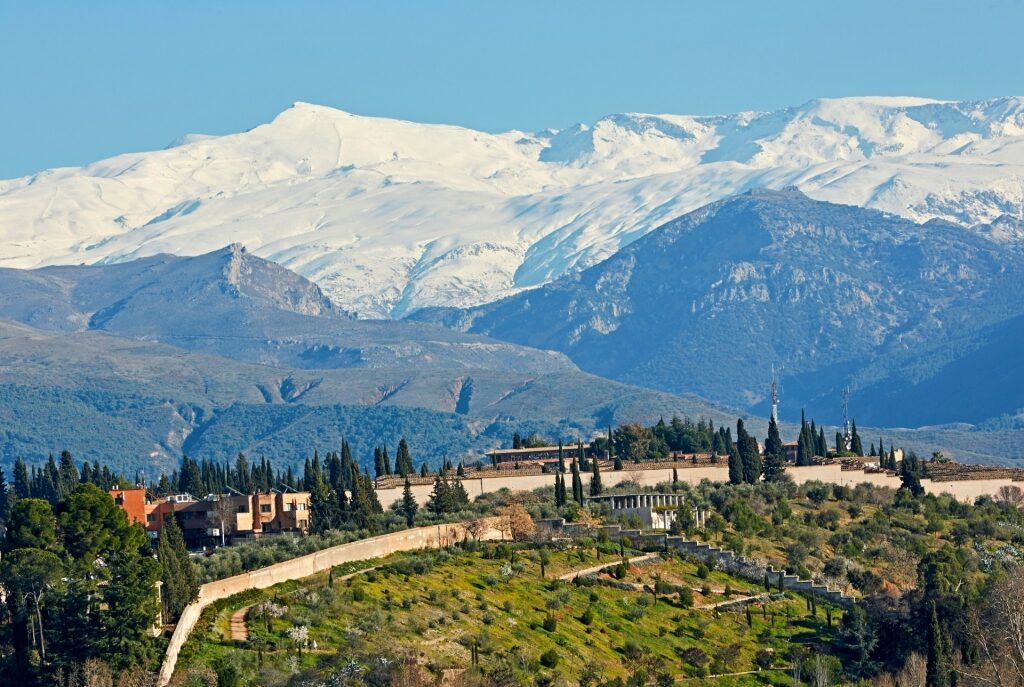
Sierra Nevada
Two of Southern Spain’s biggest draws are its magnificent beaches and its rugged mountains. In fact, after Switzerland, Spain is the most mountainous country in Europe.
The Sierra Nevada, and other wilderness terrains, host surefooted Iberian ibex goats, wild boar, the endangered Iberian lynx, beech marten, griffon vultures, imperial eagles, red-legged partridges, plus many other types of birds, lizards, and mammal species.

Common dolphins
Off the Costa del Sol, near Málaga—especially if you opt for a whale-watching tour—you might catch sight of some common or striped dolphins, or perhaps a few migrating fin whales, sperm whales, and other whale species heading toward the Strait of Gibraltar.
Things to Do & Attractions
Visit Seville’s Cathedral
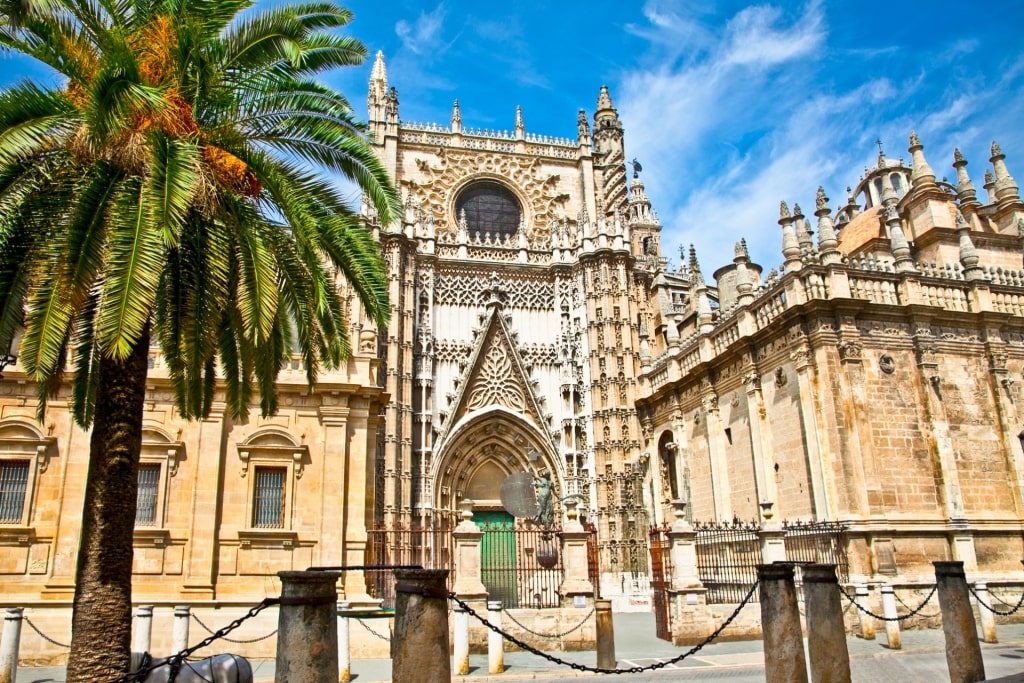
Seville Cathedral, Seville
When you’re in Seville, it’s impossible to miss the gargantuan Catedral de Santa María de la Sede, which happens to be the biggest Gothic cathedral ever built.
Construction of the Seville Cathedral, built on the site of a former mosque, along with the soaring Giralda bell tower (repurposed from the mosque’s minaret), began in the early 1400s and was finished in 1507.
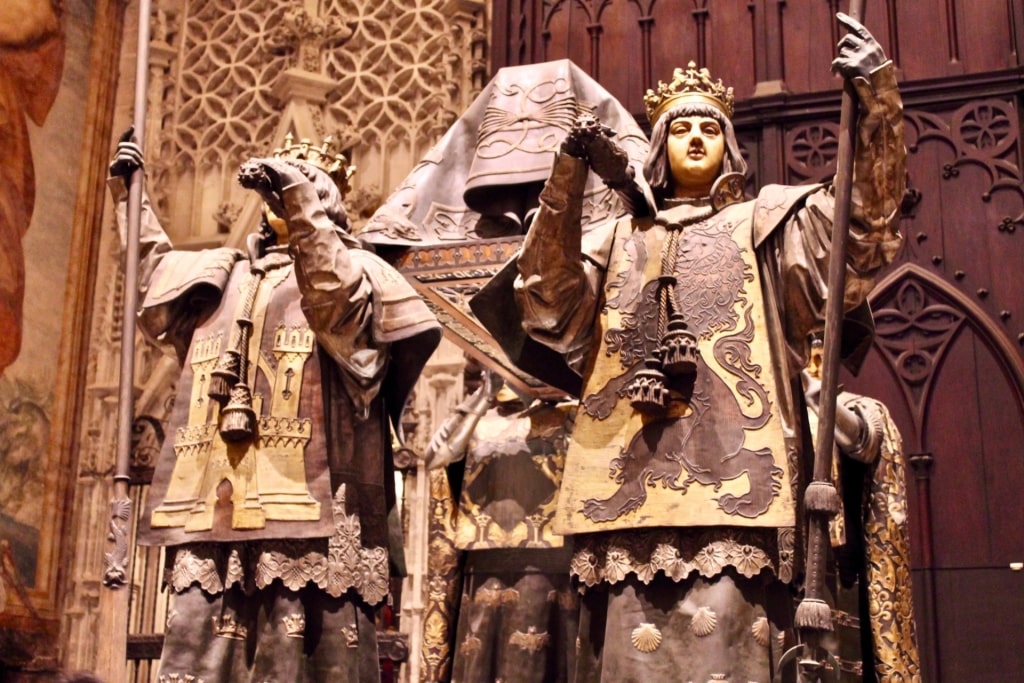
Tomb of Christopher Columbus inside Seville Cathedral, Seville
A few of the cathedral’s highlights include the tomb of Christopher Columbus, the outdoor Patio de los Naranjos with its lovely orange trees (a feature that dates back to the original mosque)—and if you’re up for it, a climb up to the top of the Giralda tower for some awe-inspiring views of Seville.
Explore the Royal Alcázar

Patio de las Doncellas in Royal Alcázar, Seville
Visiting Seville’s Royal Alcázar is one of the best things to do in Spain. This regal garden and palace is unparalleled for its serenity and splendor.
With a variety of patios to explore, such as the Patio de las Doncellas (mixing Castilian and Islamic design elements), the Patio del León, and the Patio del Yeso, the Royal Alcázar will enchant you with its peaceful charm.

Gothic Palace in Royal Alcázar, Seville
You’ll also come across a Gothic Palace with an ornate chapel here, many outdoor water features, and a massive garden with more than 20,000 plants.
Is it any wonder that this Spanish landmark, once known as al-Qasr al-Muriq, is favored by film directors as a backdrop for their movies and television series?
See the Sights of Ancient Cadiz

Castle San Sebastián, Cadiz
While you might only think of Cadiz as a jumping-off point to reach other destinations, you’ll find plenty here to keep you entertained.
If history beckons to you, visit the Spanish castle of San Sebastián and Santa Catalina, part of Cadiz’s former port battlements. San Sebastián is a small island stronghold off the northern tip of Cadiz, linked to the mainland via a stone jetty.
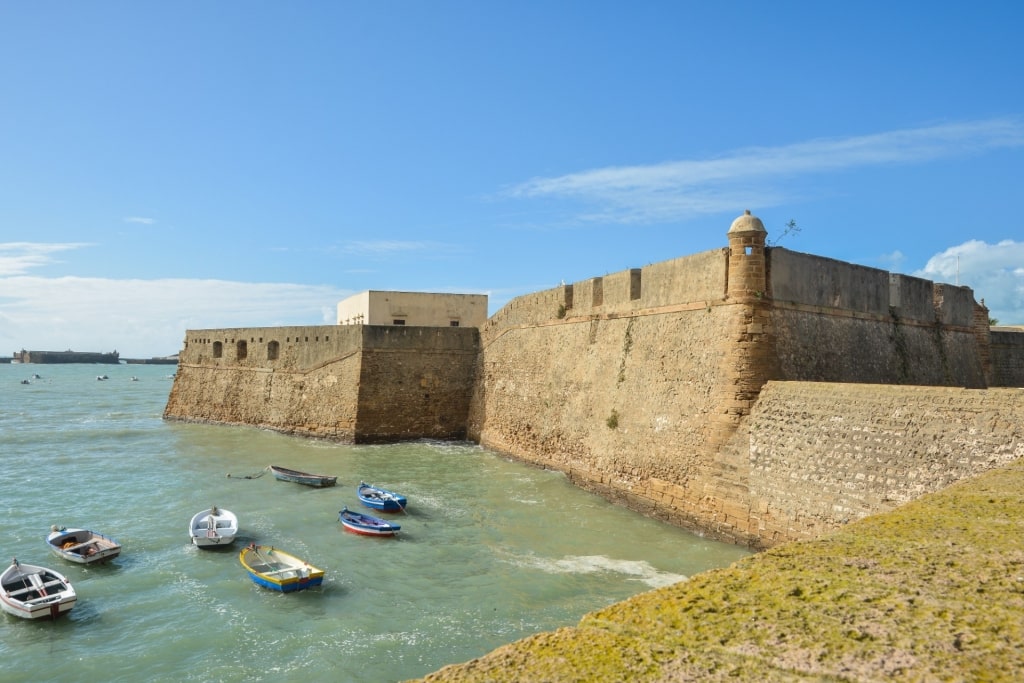
Castle Santa Catalina, Cadiz
Castle Santa Catalina, butting up against the sea next to La Caleta beach, is a fortification that now serves as an art and cultural venue. During its historic glory days, the site once housed a military prison.
The partially uncovered Roman Theater of Cadiz, dating back to around 70 BC, is a testimony to Rome’s influence in Spain and can be visited today. It was only unearthed in the 1980s).
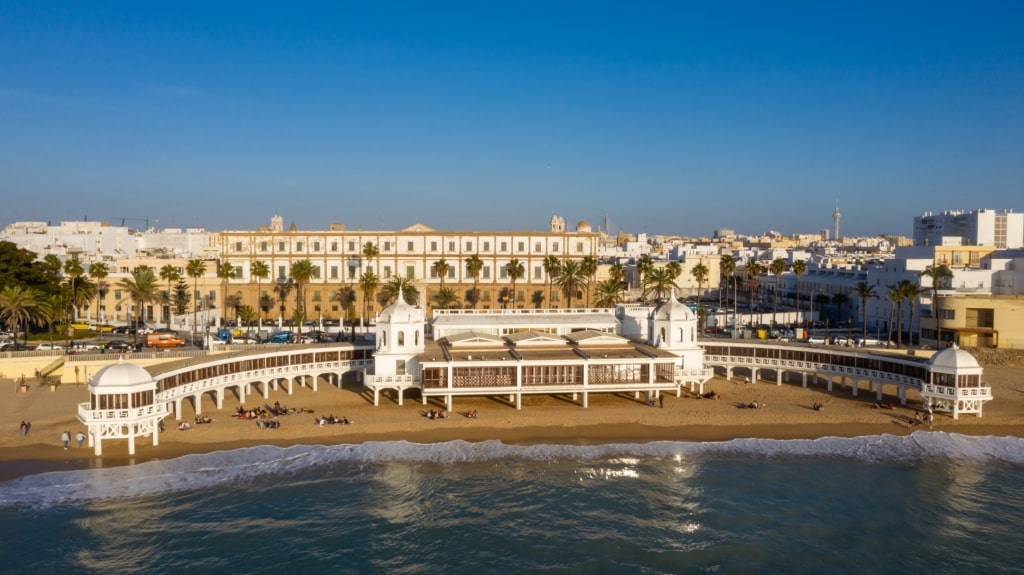
La Caleta Beach, Cadiz
For some beach time, it’s hard to beat La Caleta beach, one of the best beaches in Spain, with its cool chiringuitos (beach restaurants) plus almost 1,500 feet of silky sand.
Investigate Málaga’s Rich Architectural History
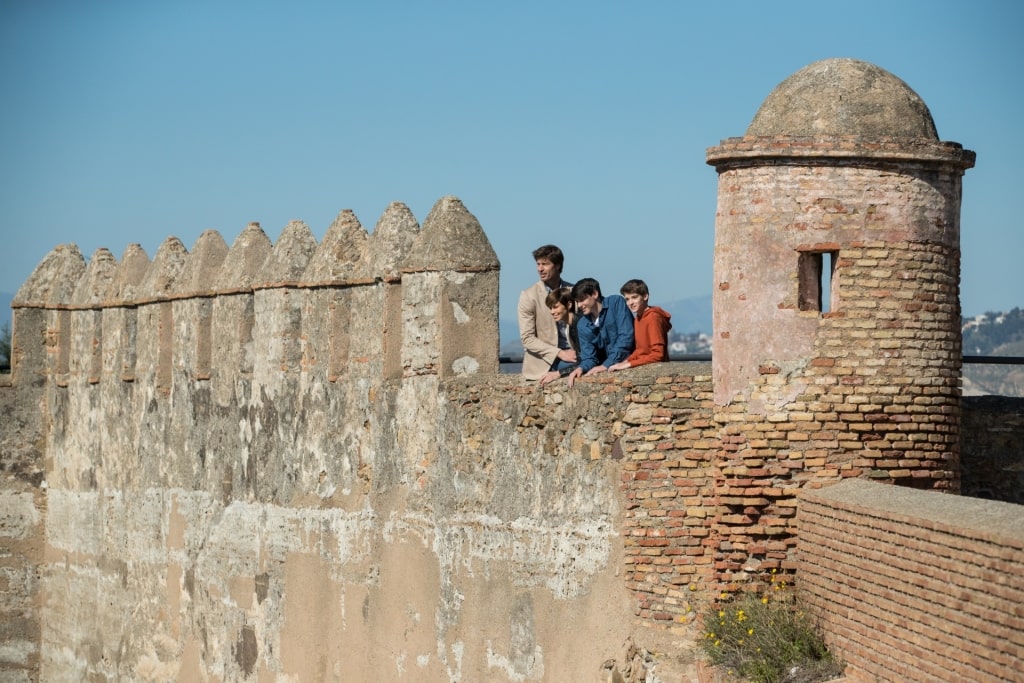
Gibralfaro Castle, Malaga
While you’ll discover plenty to keep you occupied in Málaga, if time allows, spend some time investigating the rich architectural history of this underrated European city.
A few of the city’s top historical sites include the 10th century Moorish Gibralfaro Castle, built atop Mount Gibralfaro, affording commanding views of Málaga and the sea.
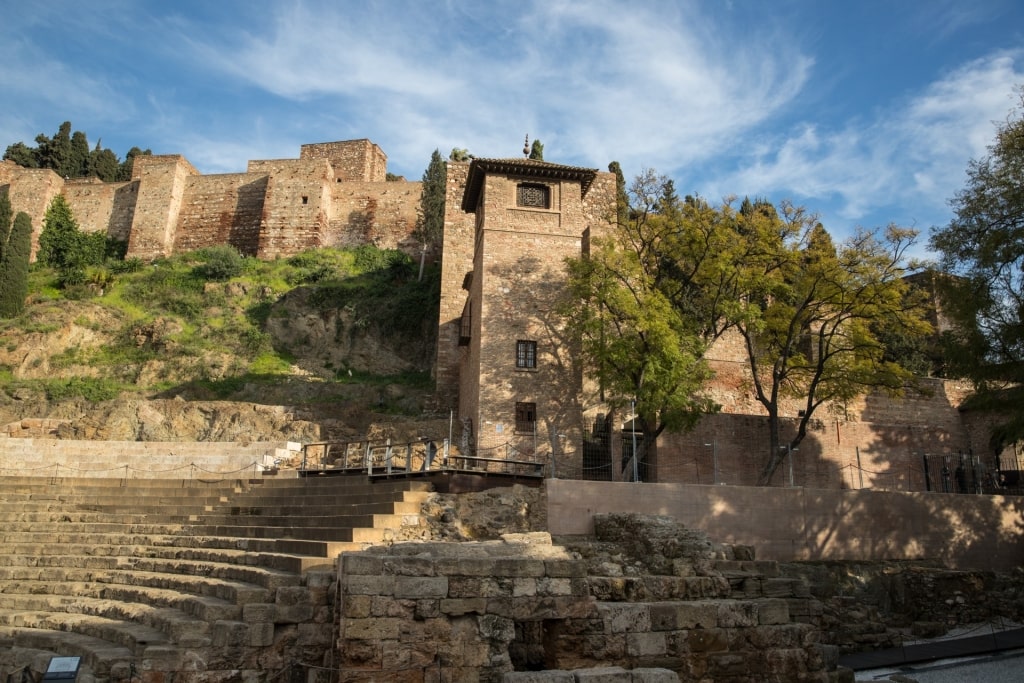
Alcazaba Palace, Malaga
At the base of Gibralfaro, in the heart of the city, you’ll stumble across the Alcazaba palace, which is a former citadel, surrounded by turrets and battlements, built to defend the port during Muslim rule.
The Roman Theater of Málaga, next to the Alcazaba, is another fascinating archeological remnant illustrating the Romans’ presence in the region.
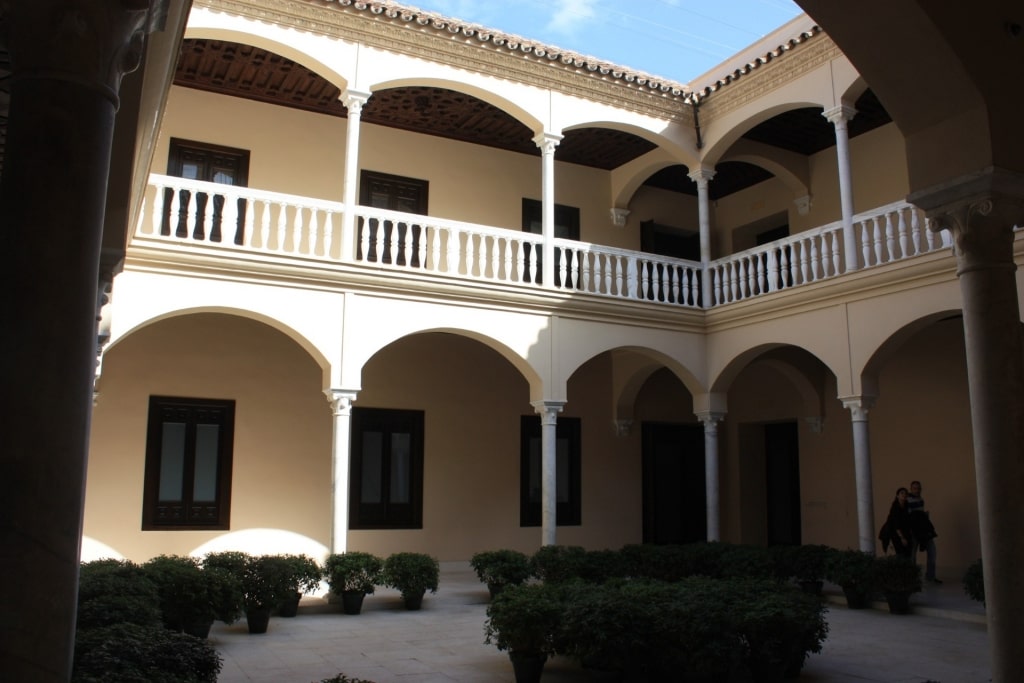
Picasso Museum, Malaga Photo by Dguendel on Wikimedia Commons, licensed under CC BY 3.0
As you wander through the centro histórico (the old town), stop at the Picasso Museum, one of the best museums in Spain. While this museum might not be dedicated to ancient history, it’s a wonderful spot to learn more about the celebrated Spanish painter Pablo Picasso, born in Málaga in 1881.
Read: Best Beaches in Malaga
Enjoy Equine, Sherry, & Flamenco Culture in Jerez
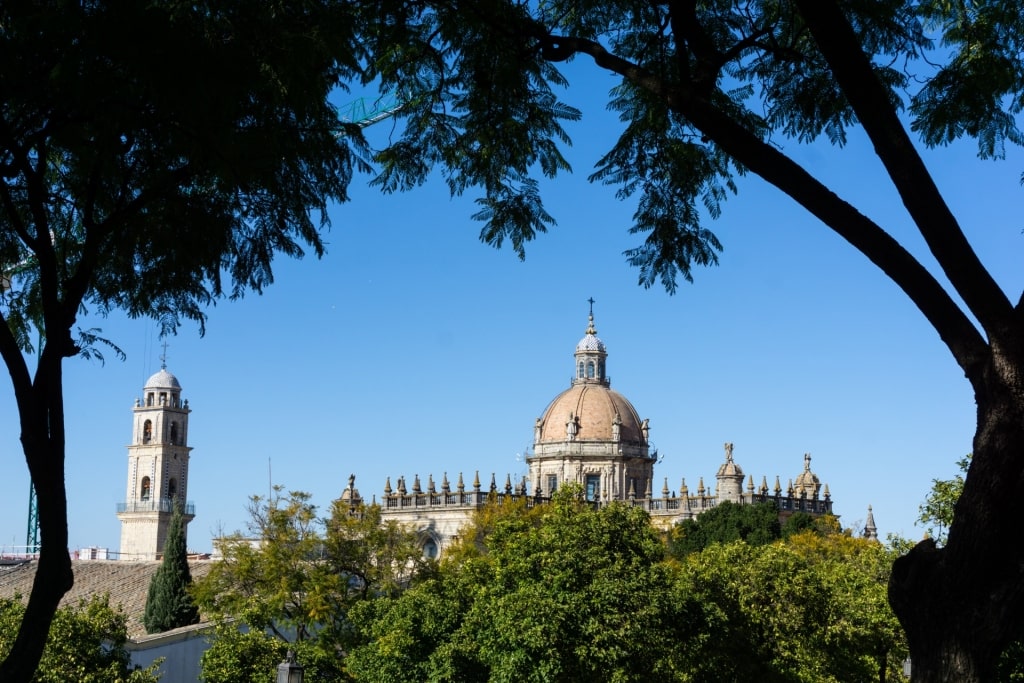
Jerez Cathedral, Jerez
Jerez de la Frontera, or simply Jerez, north of Cadiz, is an enticing town with a rich horse breeding scene, plus a long tradition of flamenco music, and sherry cultivation and production.
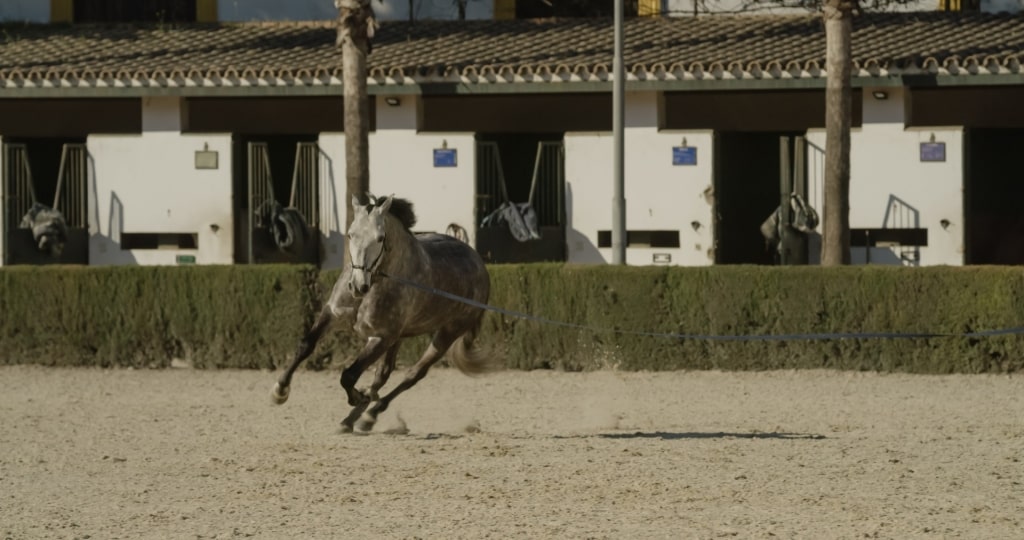
Royal Andalusian School of Equestrian Art, Jerez
Jerez’s Royal Andalusian School of Equestrian Art is where the Pure Spanish Horse, or Cartujana horse, is bred. The school is also where you can catch the graceful equestrian-themed “How the Andalusian Horses Dance” performance.

Jerez-Xérès-Sherry wine
Sherry lovers will be in heaven in Jerez thanks to the many wine cellars specializing in the local masterpiece, Jerez-Xérès-Sherry. You can call upon a cellar to sample the fortified wine and learn about its history.
Jerez is also one of the towns credited with creating flamenco, especially the rhythmically complex bulería style, performed in local bars, cafés, flamenco clubs, and by professional dance companies.
Admire the Alhambra
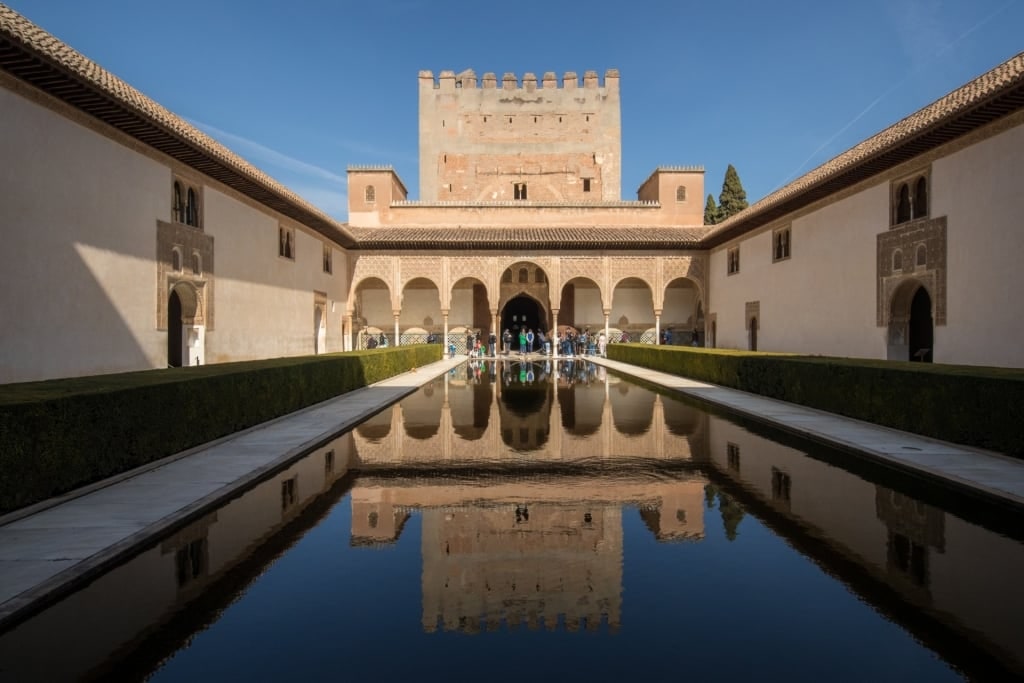
Alhambra, Granada
Granada, reaching into the snowy Sierra Nevada mountains, is a city in the south of Spain that will offer you fresh mountain air and unforgettable architecture.
The city’s cathedral, the Moorish-designed Albaicin neighborhood, and the hillside Sacromonte “gypsy quarter”, great for street music, are all worth a visit. Granada’s biggest attraction, though, is undoubtedly the Nasrid dynasty’s Alhambra Palace and the Generalife Gardens.
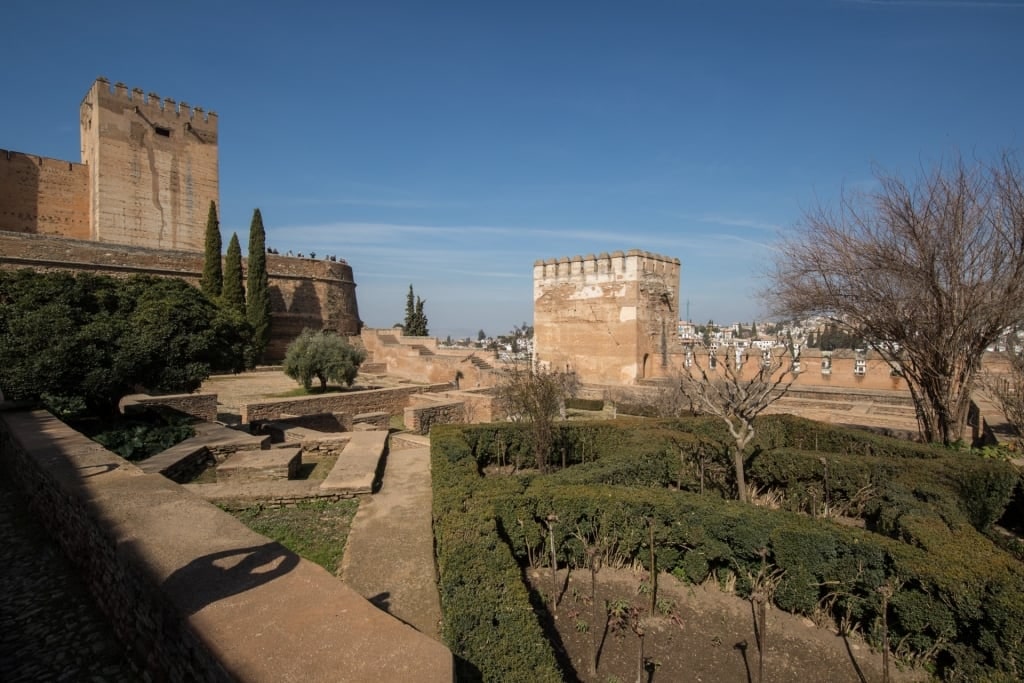
Alhambra, Granada
The Alhambra Palace, perched above the city, is one of the most beautiful places in Spain. The landmark features majestic fountains, lavish gardens, pretty courtyards, and Arabic architecture, art, and decorated tiles.
A tour of the mighty Alhambra will offer you a spacious window into Spain’s Islamic past. The palace, with its mountain backdrop, is unimaginably beautiful.
Read: Most Romantic Places in Spain
Visit Córdoba’s Great Mosque

Mezquita Catedral, Córdoba
Digging into the past further still, Córdoba is full of cobbled streets, with many houses and buildings often draped in flowers. Córdoba is also home to the Mezquita Catedral.

Mezquita Catedral, Córdoba
The Mezquita Catedral, dating back to the 8th century, has undergone several different incarnations, from a stately mosque to a Renaissance cathedral. The colossal structure’s striking corridors, numerous arches, intricate golden mosaics, and rows of Roman columns are a sight to behold.
While visiting the city, you can also lay eyes upon the Roman Bridge of Córdoba, which spans the Guadalquivir River. Although reconstructed many times over the millennia, the bridge has a 2,000-year history.

Jewish Quarter, Córdoba
If time allows, stroll through Córdoba’s Jewish Quarter and see the medieval synagogue as well. The synagogue, in use until the Jews were expelled from Spain in 1492, is a showcase of the Mudéjar architectural style.
Join the Jet Set in Marbella
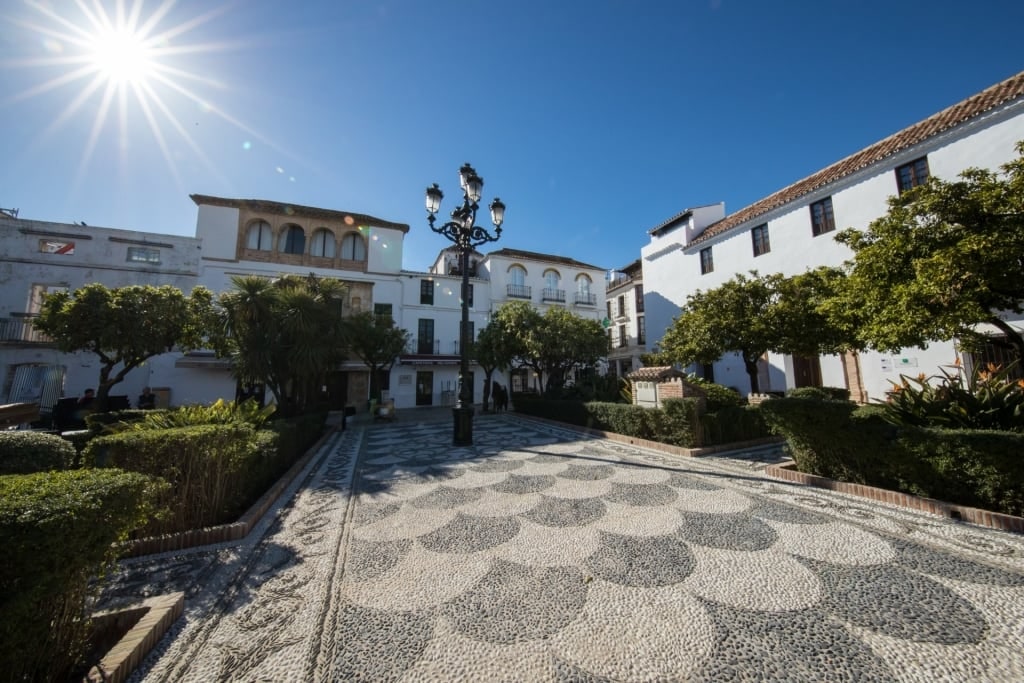
Marbella
If you’re thirsting for some glamor and high-end shopping, head to Marbella, one of the most luxurious cities in the world.
Located on the Costa del Sol, west of Malaga, this Spanish beach town is a playground for the rich and famous, not to mention golf enthusiasts, as the town is surrounded by velvety green golf courses.
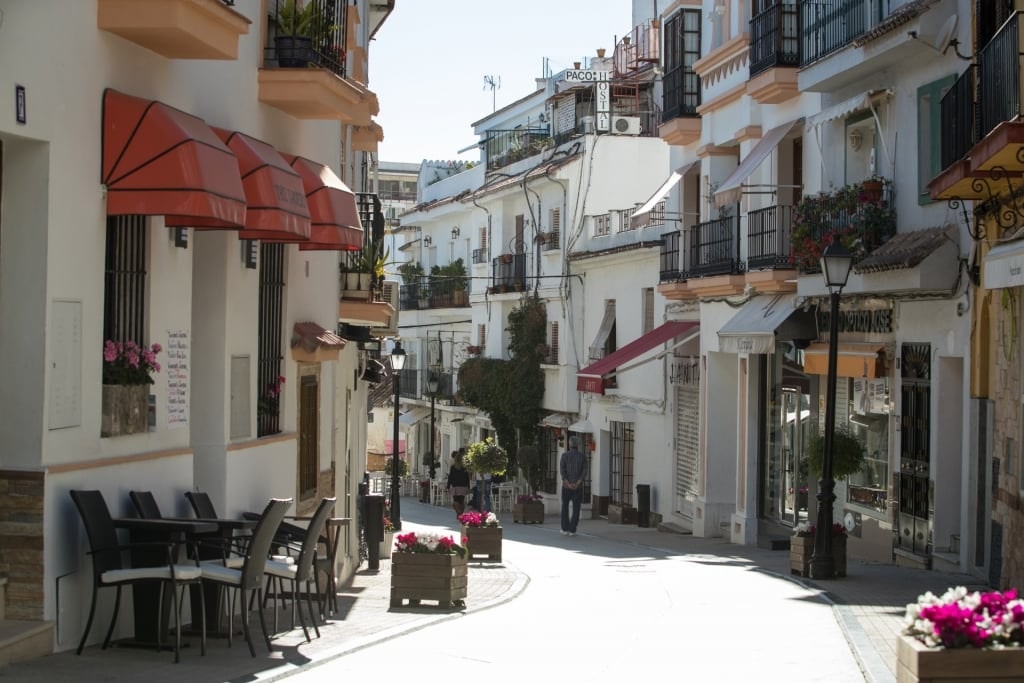
Marbella
Marbella also has an exquisite historic center, with many fragrant orange trees and white façades festooned with colorful flowers. If you’re a beach lover, you’ll enjoy the sandy beaches of Southern Spain that stretch away from the town.
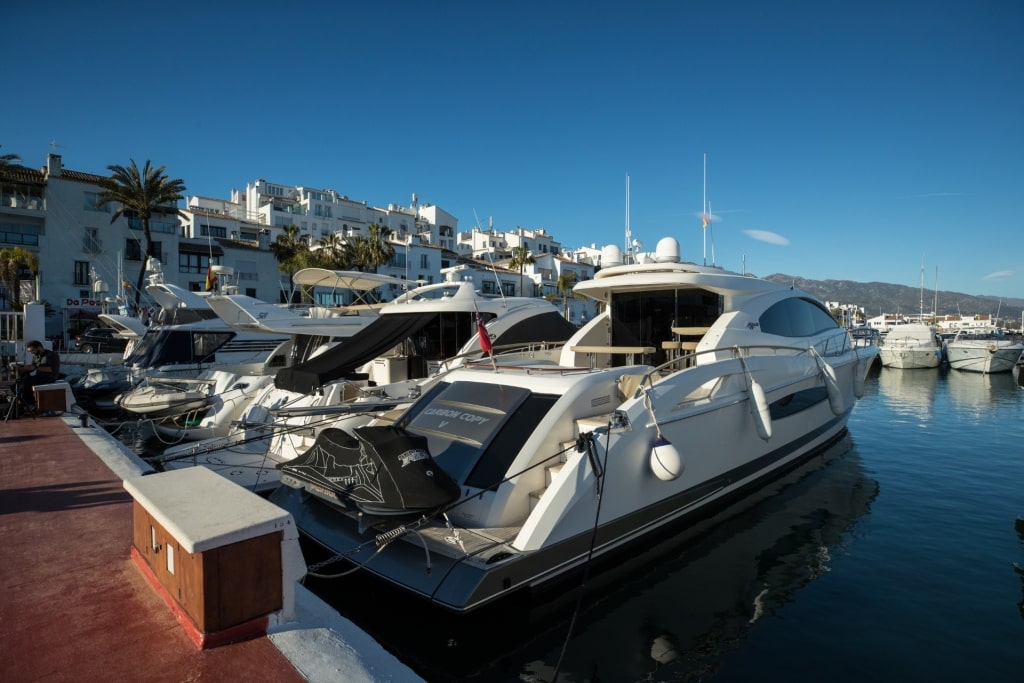
Marbella
Both Marbella and nearby Puerto Banús are magnets for the superyacht community and the berths of the marinas in both towns are routinely filled with some of the world’s most lavish private yachts. Serving the occupants of these are gourmet restaurants, ritzy boutiques, and designer shopping.
Stroll the White Town of Mijas
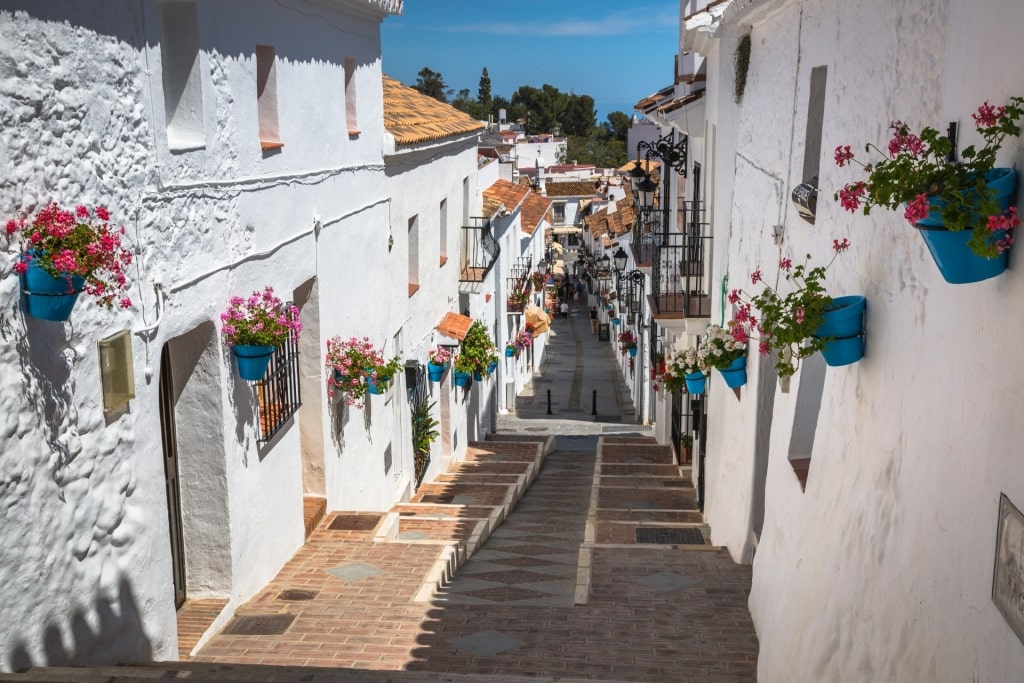
Mijas
The whitewashed houses lining the sloping streets, with clear Muslim architectural influences, make the hill town of Mijas one of the most delightful villages you’ll encounter in southern Spain.
Burro taxis in Mijas, or carriages powered by donkeys, only add to the village’s Andalusian charm.
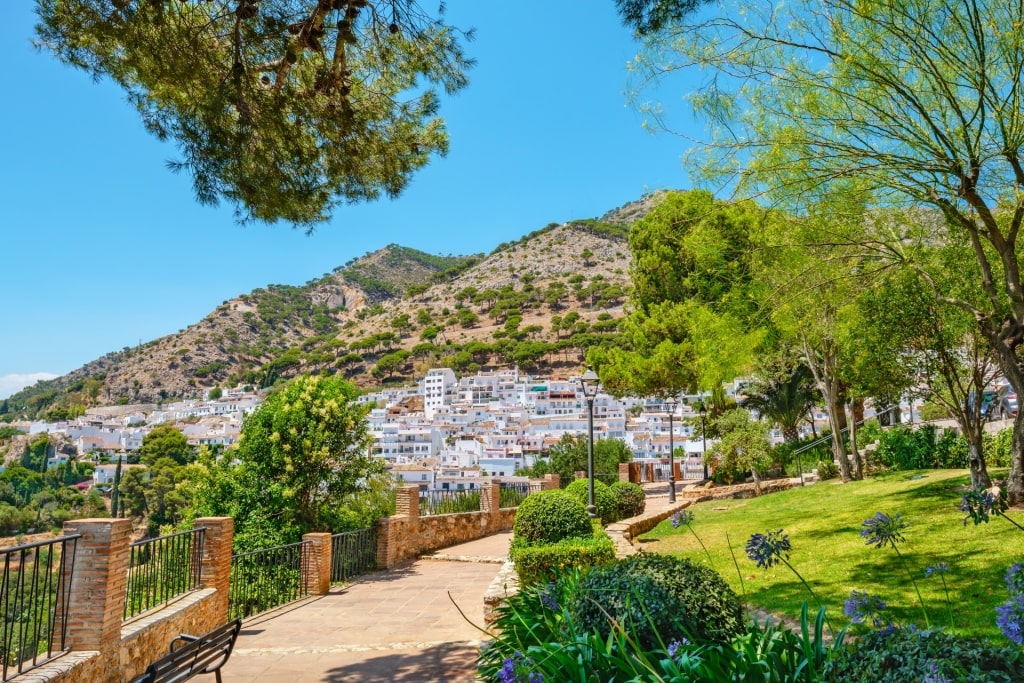
Muralla Gardens, Mijas
If you visit Mijas, easily accessible from Malaga, visit the shade-giving Muralla Gardens, built on the ruins of the old fortress. The gardens, full of flowers, offer expansive vistas of the Costa del Sol, and on clear days, across the Mediterranean to the hazy Rif mountains in Morocco.
Food & Drink
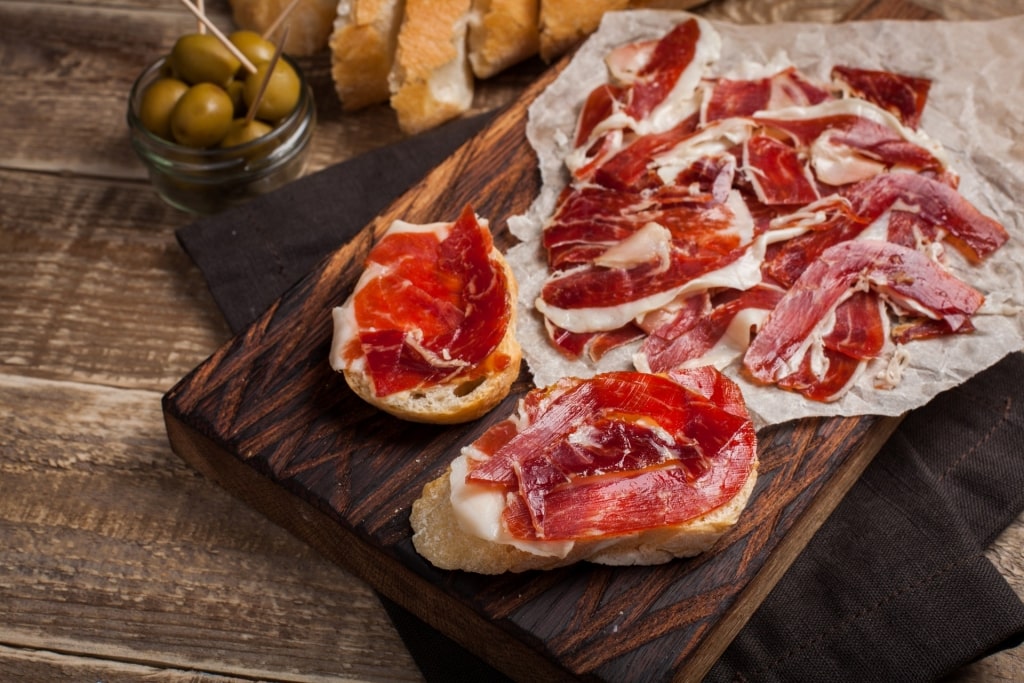
Jamón ibérico
When it comes to tasty tapas and world-class wine, the south of Spain seldom disappoints. With influences from North Africa, different religious traditions, plus input from other parts of Iberia over the centuries, Andalusian cuisine—which makes use of lots of meat, fish and seafood—has a distinct flavor.
Some regional gastronomical highlights include cured Iberian ham, or jamón ibérico, and Cordoba’s cold Salmorejo soup, not unlike gazpacho, but made only with tomatoes and garlic.
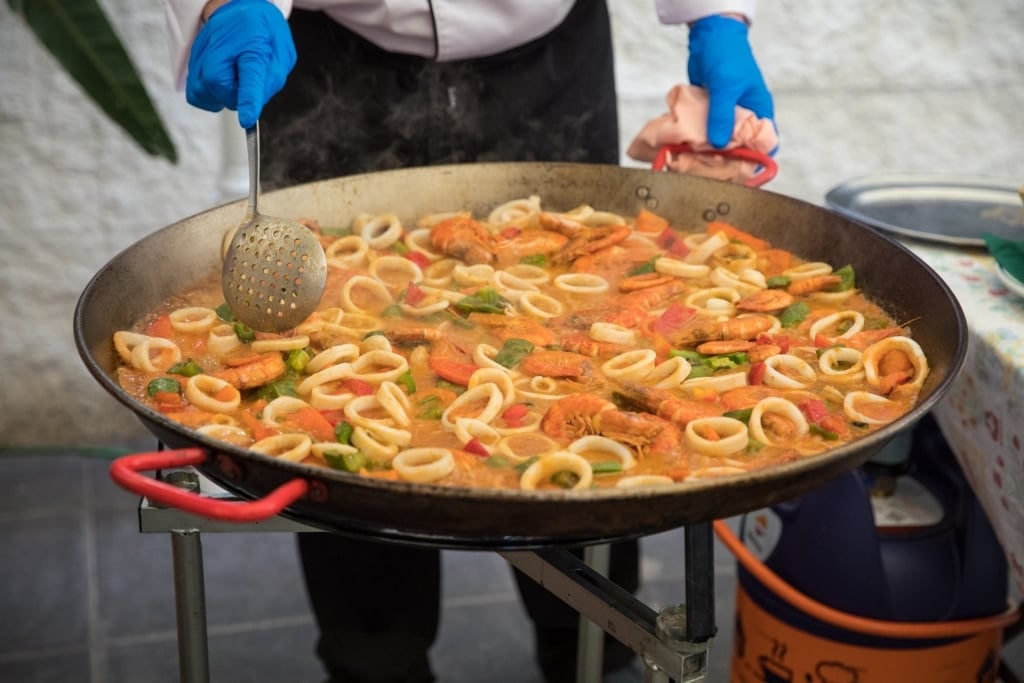
Seafood paella
Seafood paella, or perhaps paella mixta, with seafood, pork, and rabbit in saffron-infused rice, is delicious. You’ll find different varieties of fried fish, too, like boquerones, which are anchovies with less salt than usual.
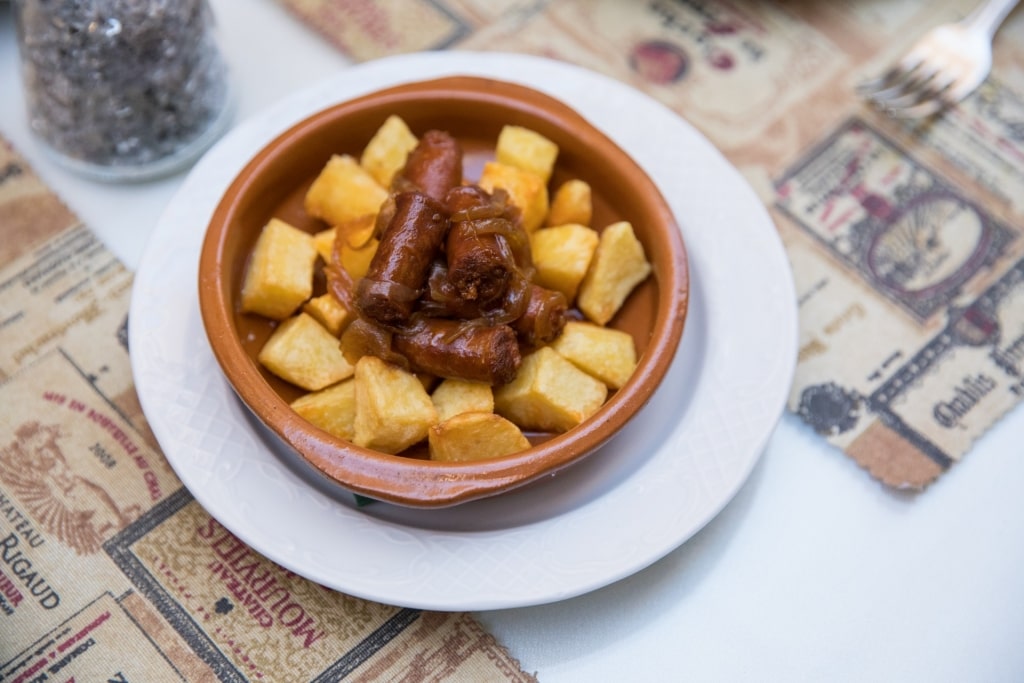
Tapas
And don’t forget those tasty bite-sized tapas in Spain, often made with cheese, grilled meat, olives, bread, garlicky shrimp, jamón ibérico, and potatoes. You’ll find wonderful tapas bars across the region, from Granada to Málaga.
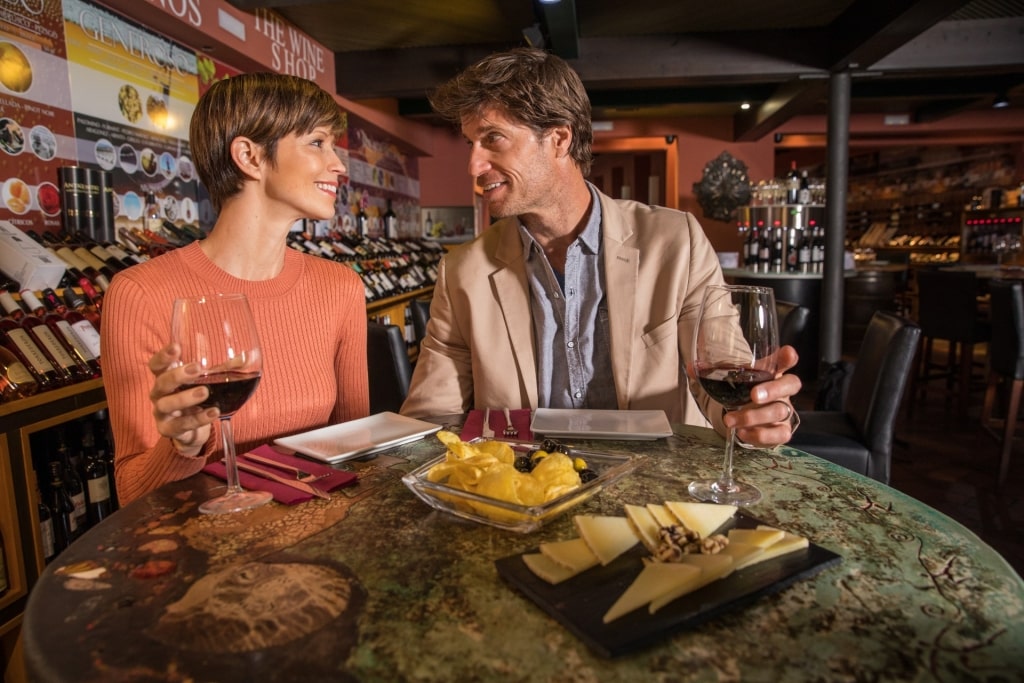
Wine tasting in Malaga
Jerez is renowned for its sherry. Málaga also happens to be known for its fortified wines. In Seville, try the Vino de Naranja, or orange wine.
Granada’s elevated climate produces many excellent wines too, with grape varieties ranging from Pedro Ximénez and torrontés to cabernet sauvignon, petit verdot, chardonnay, and many other varieties.
Best Time to Visit Southern Spain
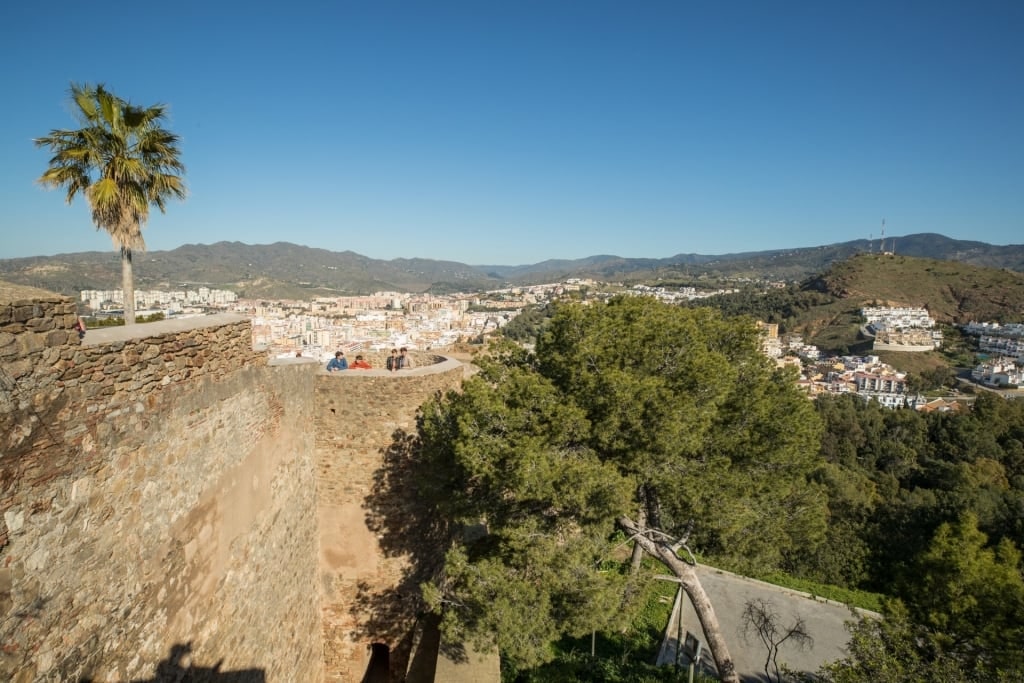
Gibralfaro Castle, Malaga
The south of Spain is one of the sunniest spots in continental Europe, with more than 300 days of sunshine a year. Midsummer can be extremely hot, so pace yourself. Spring and fall are lovely times to visit; in spring, you could still see snow on the peaks of the Sierra Nevada.
Spring is a wonderful time for hiking in Spain, while you can sit on the beach almost year-round. The sea is warm enough for swimming late into the fall.
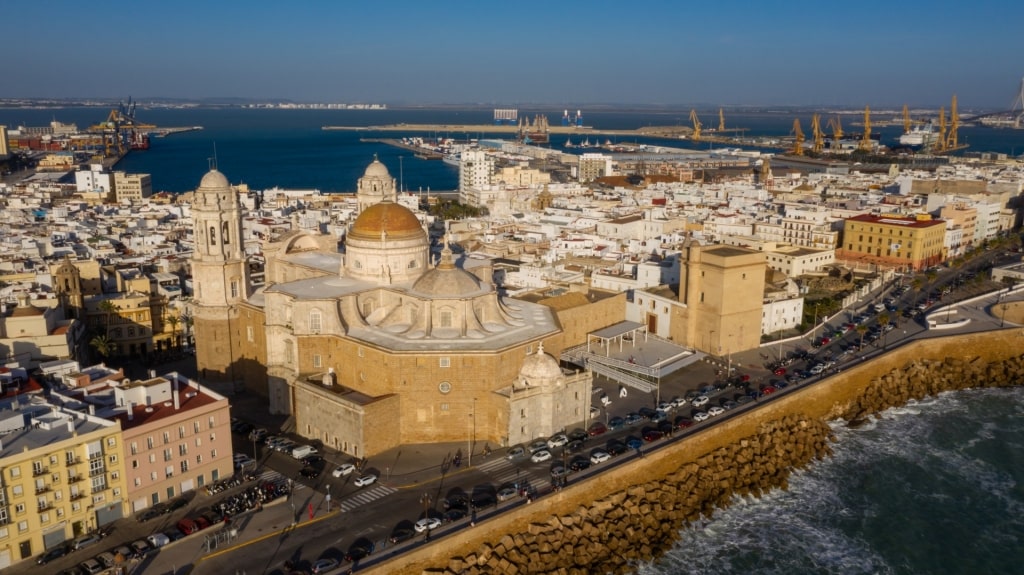
Cadiz
Discover southern Spain’s diverse culture, storied history, outstanding beaches, and tradition of culinary excellence for yourself by browsing Celebrity’s cruises to Spain.
